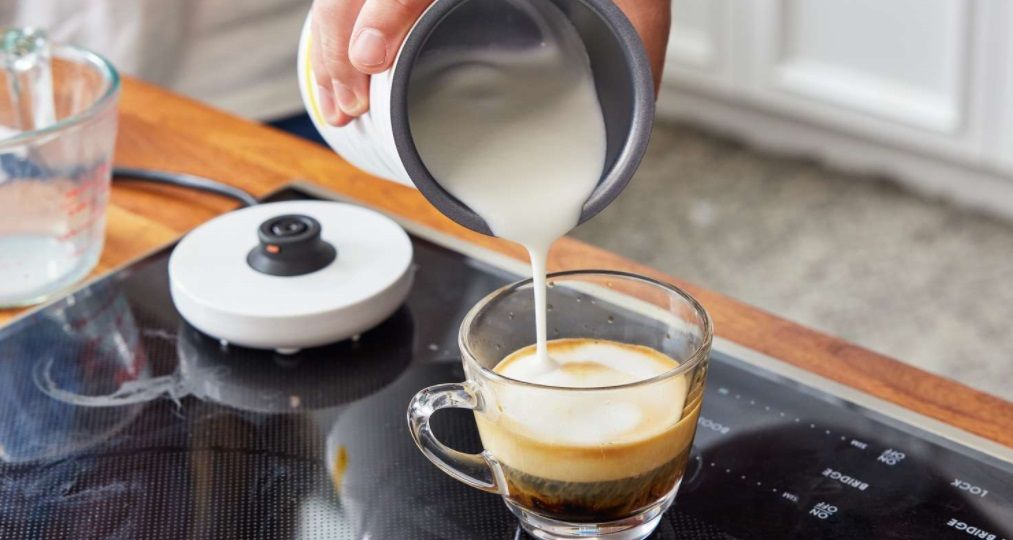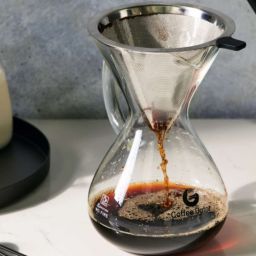
Welcome to the world of coffee making, where a little gadget called a milk frother can elevate your morning cup into a café-quality treat. A milk frother is not just a tool; it’s your ticket to creating that creamy, dreamy froth that tops off your favorite beverages. Whether you’re a coffee aficionado or just someone who enjoys a good latte now and then, understanding how a milk frother can enhance your coffee experience is essential. So, let’s dive into the frothy world of milk frothers and see what all the fuss is about!
What Does a Milk Frother Do?
A milk frother does exactly what its name suggests – it froths milk. But what does that mean? Essentially, it introduces air into the milk, causing it to become foamy, which transforms its texture and enhances its flavor when added to coffee. The process starts when the frother agitates the milk, rapidly introducing air bubbles. This not only increases the volume of the milk but also changes its consistency to something much lighter and airier than your typical milk.
The frothy milk created by these devices is a cornerstone of popular coffee drinks like cappuccinos and lattes, where the smooth, velvety layer of foam adds a luxurious texture and helps balance the robust flavor of espresso. But the magic of milk frothers doesn’t stop with coffee. The foam can be used to beautify and enrich hot chocolates, matcha lattes, and even some cocktails.
Key Takeaways on Using a Milk Frother
- Enhances flavor and presentation of coffee: A milk frother doesn’t just make your coffee look good; it enhances the overall flavor profile. The addition of airy, light foam can soften the acidity of espresso and add a smooth texture that makes each sip more enjoyable.
- Versatile in use, suitable for various milk types including non-dairy: Whether you prefer dairy milk or opt for alternatives like almond, soy, or oat milk, a good frother can handle them all. This versatility means everyone can enjoy the luxury of frothed milk, regardless of dietary preferences.
- Can be used for other beverages like hot chocolate and tea: Milk frothers are not just for coffee. You can use them to make a creamy hot chocolate or even add a frothy top to your tea, expanding your home café menu with ease.
Types of Milk Frothers
Milk frothers come in various forms, each suited to different preferences and needs. Let’s explore the most common types:
Manual Frothers: These are the simplest types of frothers, often resembling a French press. You use hand power to pump air into the milk, which is great for those who like to control the frothing process closely. They’re affordable and easy to clean, making them a great choice for beginners.
Electric Frothers: For those who value convenience, electric frothers are the way to go. They do all the work for you, heating and frothing the milk with the push of a button. These are perfect for those who make frothy drinks often or need to serve several people.
Handheld Frothers: Compact and easy to store, handheld frothers are perfect for small kitchens or for people who froth milk occasionally. They’re battery-operated and work by spinning a small whisk to aerate the milk. Handheld frothers are very affordable and straightforward to use, making them a popular choice for casual coffee drinkers.
Best Practices for Frothing Milk
Frothing milk correctly is an art that can elevate any coffee or beverage. Here are some essential tips to ensure you get the best results:
Selecting the Right Type of Milk: The type of milk you use can greatly affect the quality of your froth. Whole milk is often favored for its rich, creamy foam, but if you prefer lighter foam, skim milk is a great option. For non-dairy alternatives, oat milk and almond milk are popular choices due to their ability to froth well and hold stability.
Temperature Matters: For the best froth, use cold milk straight from the fridge. If you’re using an electric frother that heats as well, make sure it doesn’t scald the milk as this can affect the flavor and texture.
Frother Settings: Different drinks require different types of froth. For a thick, creamy froth like in cappuccinos, you’ll want to aerate the milk longer. For a silkier, smoother froth for lattes, less aeration is needed. Experiment with your frother’s settings to find what works best for each type of drink.
Proper Technique: When using a handheld or manual frother, move the frother up and down to introduce as much air as possible quickly. This helps create smaller, finer bubbles for a smoother froth.
Creative Uses of a Milk Frother Beyond Coffee
A milk frother isn’t just for coffee; its potential extends into other areas of the kitchen, enhancing both drinks and dishes with its creamy touch. Here are some creative ways to use your milk frother:
- Tea Lattes: A frother can whip up delightful frothy milk for tea lattes. Whether it’s a classic chai latte or a soothing matcha latte, the frother adds a creamy top that perfectly complements the tea’s flavor.
- Hot Chocolate: Elevate your hot chocolate with a thick layer of frothed milk on top. It makes the drink even more luxurious and inviting.
- Soups and Sauces: For a gourmet touch, use a frother to add a light, creamy foam to soups or sauces right before serving. This not only improves the texture but also enhances the visual appeal of your dishes.
- Desserts: Frothed milk can be a quick fix for desserts too. Use it to top off desserts like pies or berries for an added creamy texture without the heaviness of whipped cream.
How to Use a Milk Frother Effectively
Using a milk frother effectively means understanding the different types and how to operate them for the best foam. Here’s a step-by-step guide for each type:
Manual Frothers
- Fill the Frother: Pour cold milk up to the mark inside the frother to avoid overflow.
- Pump the Handle: Move the plunger up and down vigorously. This introduces air into the milk, creating foam.
- Pour and Enjoy: Once the milk has doubled in volume and is frothy, it’s ready to be poured over your coffee or other beverage.
Electric Frothers
- Fill and Assemble: Pour cold milk up to the designated line, then secure the lid.
- Select Settings: Choose the appropriate setting for the type of froth you desire (some frothers offer options for warm or cold froth).
- Start the Frother: Press the start button. The frother will automatically stop when the milk is perfectly frothed.
- Serve: Pour the frothed milk into your drink immediately.
Handheld Frothers
- Heat the Milk: If you prefer warm froth, heat the milk in the microwave first. Then transfer it to a deep container.
- Insert and Froth: Submerge the frother’s whisk just below the milk’s surface. Turn it on and gently move it around until the milk is frothy.
- Clean and Store: Always clean the whisk under warm water immediately after use to prevent milk residue buildup.
By following these steps, you can ensure you get the perfect froth every time, whether you’re making a latte at home or adding a splash of luxury to your morning coffee.
Cleaning and Maintaining Your Milk Frother
Keeping your milk frother clean and well-maintained is crucial for its longevity and performance. Here’s how to keep it in tip-top shape:
After Every Use
- Clean Immediately: Milk residues can harden quickly, making them difficult to clean later. Rinse the frother or wash it according to the manufacturer’s instructions right after use.
- Use Soapy Water: For manual and handheld frothers, disassemble (if possible) and clean all parts with warm, soapy water. For electric frothers, wipe down the outside and clean any removable parts similarly.
Deep Cleaning
- Monthly Maintenance: Even with regular cleaning, it’s good to do a deeper clean monthly. Use a solution of vinegar and water to help dissolve any milk scale or buildup.
- Check for Residue: Pay special attention to the whisk and any nooks where milk can accumulate. A small brush can be helpful in these areas.
Handling and Storage
- Handle with Care: Frothers are generally quite durable, but handling them gently helps prevent damage to sensitive components like the motor or battery compartment.
- Proper Storage: Store your frother in a dry place and ensure handheld or manual frothers are thoroughly dried before storing to avoid mildew or corrosion.
FAQs
What is the best milk for frothing?
The best milk for frothing is typically whole milk due to its higher fat content, which creates a richer, more stable foam. Skim milk can also be used for a lighter foam, while non-dairy alternatives like oat and almond milk are popular choices for their good frothing capabilities and suitability for those with dietary restrictions.
How do I troubleshoot my milk frother if it’s not working properly?
If your milk frother is not functioning correctly, start by ensuring it is clean, as residue can affect performance. Check that it is properly charged or plugged in, and make sure all parts are correctly assembled. If problems persist, consult the user manual or manufacturer’s support for specific troubleshooting guidance.
What are the differences between steamed milk and frothed milk?
Steamed milk is gently heated and slightly aerated, creating a creamy texture with minimal foam, ideal for lattes. Frothed milk involves more aggressive aeration, resulting in a thick, voluminous foam perfect for topping cappuccinos and other specialty beverages.
Final Thoughts
Milk frothers truly transform the coffee experience, adding a professional touch to your home-brewed beverages. They allow coffee enthusiasts to elevate ordinary drinks into something extraordinary, providing that creamy, barista-style texture that makes each sip more enjoyable. Their versatility extends beyond coffee, enabling the creation of a variety of frothy beverages anytime.









